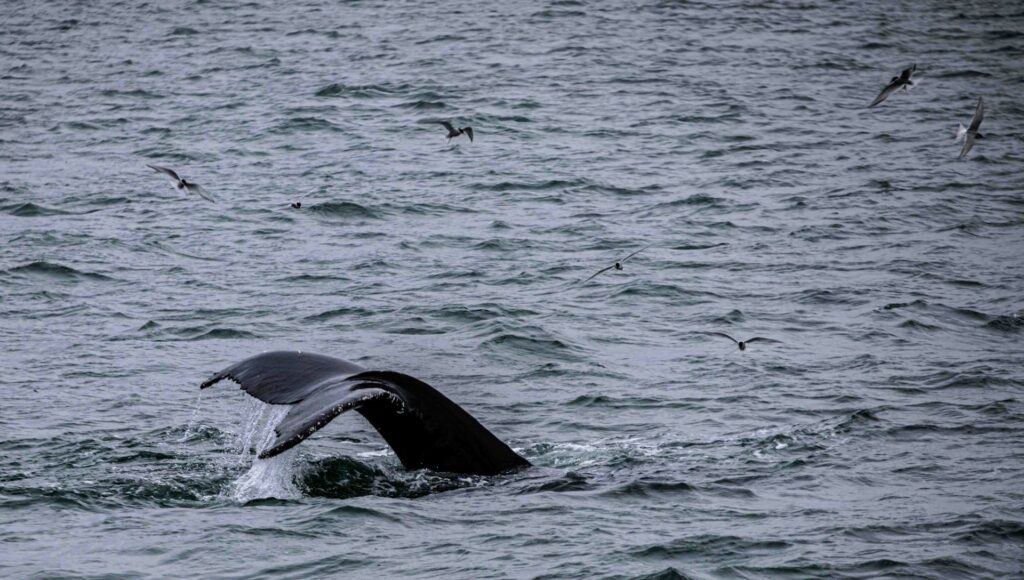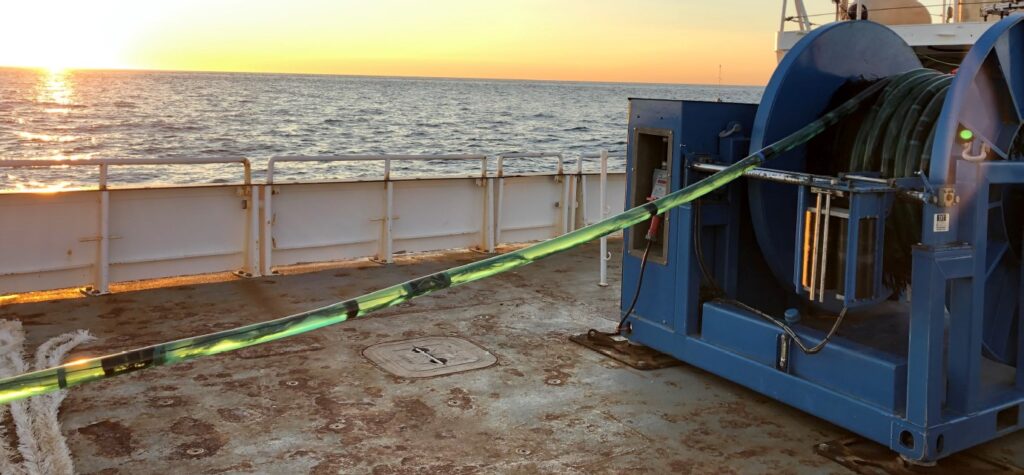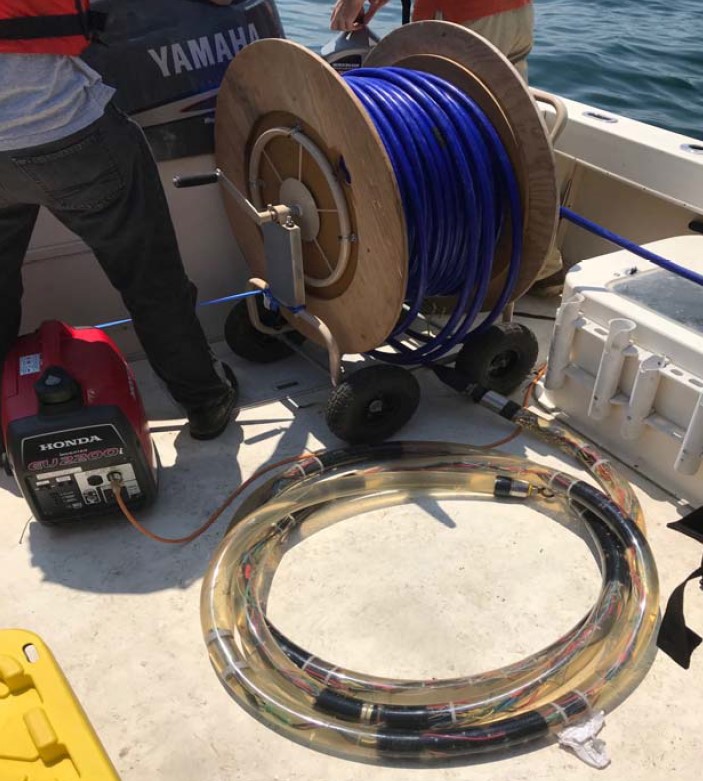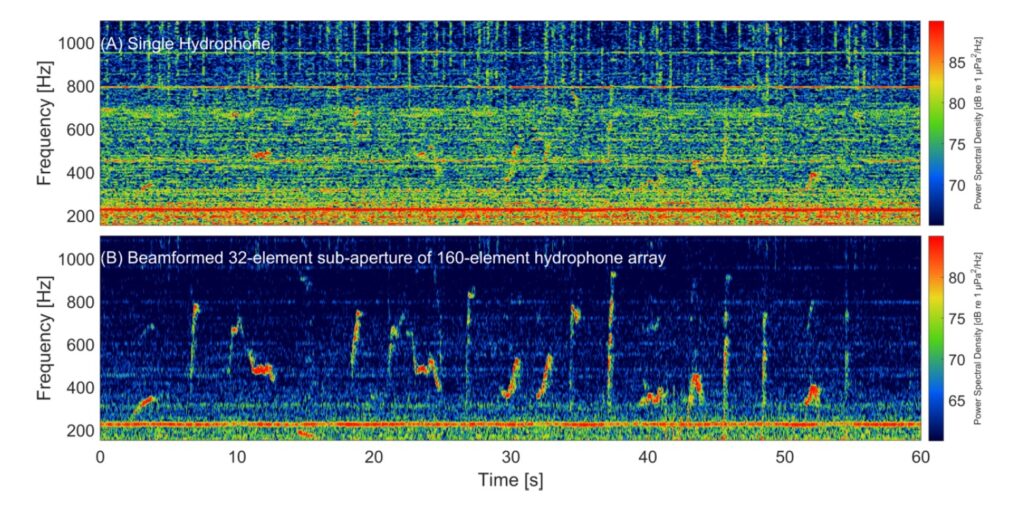How a Northeastern lab developed one of the largest underwater microphone arrays in academia, bolstering the research community’s ability to listen to marine ecosystems

In early September 2021, researchers lowered a device into the water for the first time, off the coast of Rhode Island. It’s a string of wires, electronics and microphones that look like Christmas lights but a tenth of a mile long. When the researchers finally turned it on, it recorded the sounds of marine life in an area larger than the state of Connecticut.
They heard whales singing in “whoops” and “woos,” buzzing like a zipper, creaking like a door and blowing bubbles. The dolphins whistled and clicked. The fish used air-filled swimming bladders to grunt and “knock” like a hand on wood. It was a rich soundscape, a portrait of an underwater world.
Light doesn’t travel nearly as far underwater as above. Sound, on the other hand, can travel a greater distance in water than in air. “That’s why all of the ocean organisms have developed sound as the primary mechanism for communication,” says Purnima Ratilal, a professor of Electrical and Computer Engineering at Northeastern and director of the lab developing the array. The researchers are taking advantage of this phenomenon.

The array consists of 160 hydrophones, a type of underwater microphone, developed by Northeastern’s Laboratory for Ocean Acoustics and Ecosystem Sensing. It’s one of the longest — and most cost-effective — wide-band sensing arrays in academia. With this combination of price and power, the team aims to give researchers around the world unprecedented access to its extraordinary sensing capability: not only continuously recording faint sounds over large areas but also pinpointing where each sound originates. It’s not just for the wonder of hearing such peculiar sounds. The recordings from the device — and the greater understanding of ecosystems that they provide — can aid marine life conservation and management.
Science using ocean sounds
In a 2019 excursion, the Northeastern team brought a prototype of their hydrophone array to the lower west coast of Norway to listen for coastal cod fish during mating season. Over a few days, they heard thousands of cod grunts and knocks and were able to map the distribution of the fish. The researchers say the results show that the technique could be used to learn about the reproductive habits of the fish and help manage the species’ numbers, as they are vital to fisheries, commerce and the diets of Norwegians. The team has multiple expeditions with the device already lined up for the coming years.
The ability to hear marine species in real-time over such a large area makes these devices ideal for monitoring not just the individual creatures themselves, but entire ecosystems. The hydrophones allow scientists to map multiple species in relation to one another, study their habits and understand the impact of human activity, like fishing. They can also monitor the sound levels of ocean infrastructure projects like offshore drilling and wind farms.
“We listen to everything. It’s a really good tool to say, ‘hey, look, this is exactly what is going on,’” says Matthew Schinault, a Ph.D. student who’s been working on the project since he was an undergraduate.
Most of the hydrophone arrays in operation are owned by the Navy and defense contractors, where they’re primarily used for locating vessels. Schinault says that developing the tool at the university level allows the researchers to provide a full picture, without ulterior motives. “We’re not doing stuff for the military, and we’re not conservationists. We’re scientists.”
How hydrophones hear
The massive array had humble beginnings. The project’s first expedition started on a dreary, cold October morning in 2018, right in the middle of hurricane season. Schinault had called up his fisher acquaintances for a ride. One offered his boat, but not before some tongue-in-cheek responses — why would you want to toy with a heavy contraption when you could go fishing? With a science crew of five, they headed toward whale-watching boats they had tracked on a maritime traffic website. Miles off the coast in Massachusetts Bay, they dropped in a prototype of the device, 25 feet long with eight microphones.

With the prototype, they were attempting to demonstrate the primary benefits of using an array of hydrophones strung together in a row, as opposed to a single hydrophone.
If “you have just one sensor, you get sound coming from all different directions, and you cannot tell where the sound is coming from,” says Ratilal. “That’s why we also have two ears, to allow for stereographic projection to figure out directions.”
Additionally, using a technique called “beamforming,” the researchers can greatly increase the signal-to-noise ratio with hydrophone arrays. After identifying the direction of the sound, they enhance the sound in that direction and suppress noise coming from elsewhere.

After the Northeastern team first dropped the prototype into Massachusetts Bay, they crowded around the computer bolted to the wooden desk inside the rocking boat. Then, the array heard a low, soft sound sweeping downward in pitch: a humpback whale.
“We start seeing it on a computer screen. I was just ecstatic … It felt like we had this connection because I’ve been listening to their vocalizations for so long,” says Schinault.
With the array, they could track the whale, who was close to the surface popping up for air a little over a mile away. Over the course of the day, they heard several other whales and the distant hum of the whale-watching vessel.
Melding all of these sound processing techniques together to create a real-time map of what is making sounds and where is no simple task. Hamed Mohebbi-Kalkhoran, an MIT postdoc who completed his Ph.D. in the Northeastern lab, works on the software responsible for this technology. To make it happen, the program first identifies a sound through the background static, then classifies what creature is responsible for the vocals and finally where that creature is swimming — and it does all of this the second the audio waves hit the hydrophones.
The basement was the beginning
Ratilal’s team developed the full 160-hydrophone array — a device twice as long as a football field — in a basement lab space no bigger than a bedroom. The team works on it in smaller chunks when possible — roughly 50 to 150 feet sections — but when the whole array needs an upgrade or testing, the team utilizes every corner of Northeastern’s Boston urban campus.
Early in the project, the team snaked the array along the floor of the Renaissance Parking Garage to slide the electronics into a protective rubber-like tube. With their pump and five-gallon buckets of vegetable oil, they filled the tube with oil to prevent the device from imploding under intense ocean water pressures.
To test the array before deploying it in the ocean, the researchers headed to the Cabot Center pool and threw it in with a large speaker. And during the early stages of the pandemic, Schinault even brought sections back to his electronics workbench at his home.
Schinault works on the electronics with another Ph.D. student, Max Radermacher. They’ve developed a design that sections the device into compartments that can be worked on individually, and while every component must be designed to withstand high pressures, they use as many commercially available electronics as possible. The result is a device that’s easy to repair and cheap to build.
As much fun as the team had — and as much curiosity as their efforts sparked from passersby — the team plans to move many of the array’s larger assembly tasks up to Northeastern’s Burlington campus, where they hope to produce modular arrays that make the tool more accessible to the research community.
“I think the vision for the future is to have compact systems so we can get a lot of folks using this,” says Schinault. “I feel like we’re on the ground floor for a whole new era of underwater exploration.”
Story from the Science Media Lab.
Last Updated on January 16, 2024
